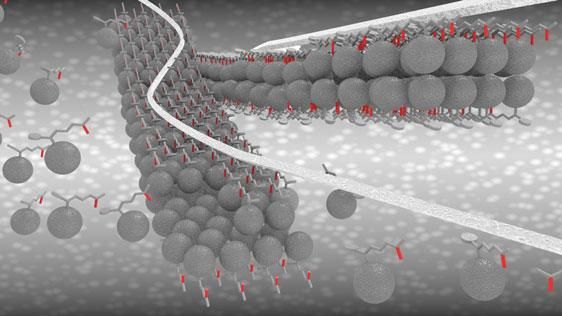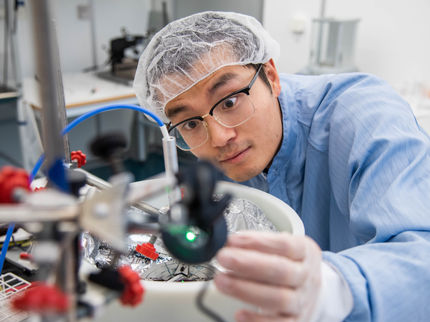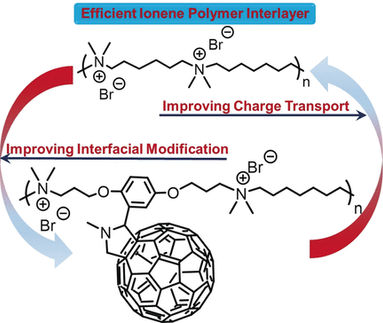Molecular nanoribbons as electronic highways
Physicists at Umeå University have, together with researchers at UC Berkeley, USA, developed a method to synthesise a unique and novel type of material which resembles a graphene nanoribbon but in molecular form. This material could be important for the further development of organic solar cells.

This is a schematic image, showing the PCBM nanoribbons, comprising four PCBM molecules organized side by side. The grey balls represent the fullerene molecules (each consist of 60 carbon atoms), and the attached side arms are characteristic for PCBM molecules. The white 'speed tracks' represent the ability for the nanoribbons to form electronic highways.
Umeå University
The nanoribbons are comprised of molecules with the chemical formula [6,6]-phenyl-C61-butyric acid methyl ester. For short it is denoted PCBM, and in practice it is a fullerene molecule (a football-shaped carbon molecule) with an attached side arm to increase its solubility. PCBM molecules are commonly used in organic solar cells since they have a very good ability to transport free electrons that are “generated” by solar light.
The researchers at Umeå University and UC Berkeley have now developed a method to arrange such molecules into thin, crystalline nanoribbons that are only four nanometres wide. The nanoribbons are grown in a solution process with quite high efficiency and all nanoribbons have a unique morphology with edges in a zigzag.
“It is a very intriguing material and the method is quite simple. The material resembles the more commonly known graphene nanoribbons, but in our material each carbon atom is ‘replaced’ by a molecule,” says Thomas Wågberg, associate professor at the Department of Physics, who has led the study.
The findings are interesting for several reasons; it is the first time that structures with so small dimensions have been produced with this type of molecule, and the dimensions of the nanoribbons suggest that they should be ideal as “electronic highways” in organic solar cells. An organic solar cell usually consists of two types of material, one that conducts the electrons and one that conducts the “holes” that are left behind when the electron gets an energy boost from the incoming solar light.
An electron conductor in organic solar cells should ideally form long pathways to the electrode but concurrently be thinner than 10-15 nanometres. The newly developed PCBM nanoribbons fulfil all these requirements.
“Together with professor Ludvig Edman’s group at the Department of Physics at Umeå University, we are now investigating this material further as a potential component in organic solar cells in the hope of making such devices more efficient,” says Thomas Wågberg.
Our study is of course also interesting for fundamental reasons since it opens up possibilities to investigate important physical properties of molecular materials with nanoscale dimensions.
Original publication
Other news from the department science

Get the chemical industry in your inbox
By submitting this form you agree that LUMITOS AG will send you the newsletter(s) selected above by email. Your data will not be passed on to third parties. Your data will be stored and processed in accordance with our data protection regulations. LUMITOS may contact you by email for the purpose of advertising or market and opinion surveys. You can revoke your consent at any time without giving reasons to LUMITOS AG, Ernst-Augustin-Str. 2, 12489 Berlin, Germany or by e-mail at revoke@lumitos.com with effect for the future. In addition, each email contains a link to unsubscribe from the corresponding newsletter.




























































